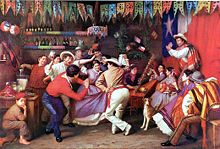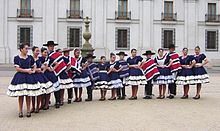- Cueca
-
Cueca (Spanish pronunciation: [ˈkweka]) is a family of musical styles and associated dances from Chile, Bolivia, Peru, and Argentina. In Chile, the cueca holds the status of national dance, where it was officially selected on September 18, 1979.[citation needed][1]
Contents
Origins
While its origins are not clearly defined, it is considered[who?] to have Spanish and African influences, among others. The most widespread version of its origins relates it with the zamacueca which arose in Peru as a variation of Spanish Fandango dancing with criollo and African influences. The dance is then thought[who?] to have passed to Chile and Bolivia, where its name was shortened and where it continued to evolve. Due to the dance's popularity in the region, the Peruvian evolution of the zamacueca was nicknamed "la chilena", "the Chilean", due to similarities between the dances. Later, after the Pacific War, the term marinera, in honor of Peru's naval combatants and hostile attitude towards Chile was used in place of "la chilena." The Marinera, Zamba and the Cueca have different styles that distinct them from each other and their "root" which is the zamacueca.
Another theory is that Cueca originated in the early 19th century bordellos of South America, as a pas de deux facilitating partner finding.[2]
The usual interpretation of this courting dance is zoomorphic: it tries to reenact the courting ritual of a rooster and a hen. The male displays a quite enthusiastic and at times even aggressive attitude while attempting to court the female, but the dance often finishes with the man kneeling on one knee, with the woman placing her foot triumphantly on his raised knee.Clothing and Dance
The clothing worn during the cueca dance is very traditional Chilean clothes. The men in the dance wear the huaso's hat, shirts, flannel poncho, riding pants and boots, short jacket, riding boots, and spurs. Women wore flowered dresses with an apron. (spotlightonchile.com) The dance of the cueca is done with a sense of the rooster and the chicken. The man approaches the woman and offers his arm, then the women accompanies him and they walk around the room. They then face each other and hold their handkerchief in the air, and being to dance. They never touch, but still maintain contact through facial expressions and movements. The white handkerchief must be waved; this writer has seen Chileans using paper handkerchieves from a box rather than dance the cueca without one.(spotlightonchile.com)
Basic structure
The basic structure of the cueca is that it is a compound meter in 6/8 or 3/4 and is divided into three sections.
Some differences can be noticed depending on geographical location. There are three distinct variants in addition to the traditional cueca:
- The northern cueca: The main difference with this version is that there is no singing in the accompanying music which is played with only sicus, zamponas, and brass. trumpets, tubas. Also, both the music and the dance are slower. This dance is done during religious ceremonies and carnival. (www.guitarrachilena.cl.php).
- The cueca from the central region: This genre is mostly seen in Chile. The guitar, accordion, guitarron, and percussion.
- The Chiloé cueca: This form has the absence of the cuarteta. The seguidilla are repeated and there is a greater emphasis on the way the lyrics are presented by the vocalist.
Today
Currently, the cueca is mainly danced in the countryside, and performed throughout Chile each year during the national holidays in September. Dancing competitions of cueca are popular around that time of year.
In Bolivia there are lots of different Cueca styles according to the region: Cueca Paceña, Cueca Cochabambina, Cueca Chuquisaqueña, Cueca Tarijeña, Cueca Potosina y Cueca Chaqueña. What they have in common is their rhythm, but they differ quite a lot in velocity, costumes and style. The Cueca styles of La Paz, Potosí and Sucre are the elegant ones, whereas in Cochabamba and Tarija the style is much more lively.In Bolivia, it is usually called "Cuequita Boliviana"
See also
References
- ^ http://www.guitarrachilena.cl/eng_cueca.php
- ^ Journeyman Pictures reporter Mark Corcoran's documentary with Mario Rojas and Pinochet-era victims' families on Youtube (please disregard political connotations)
- Demonstration of Bolivian cueca (and other folk dances specific to the Gran Chaco region) on Youtube
Categories:- Bolivian culture
- Argentine styles of music
- Chilean culture
- Peruvian dances
- Bolivian dances
- Chilean dances
- Argentine dances
Wikimedia Foundation. 2010.



